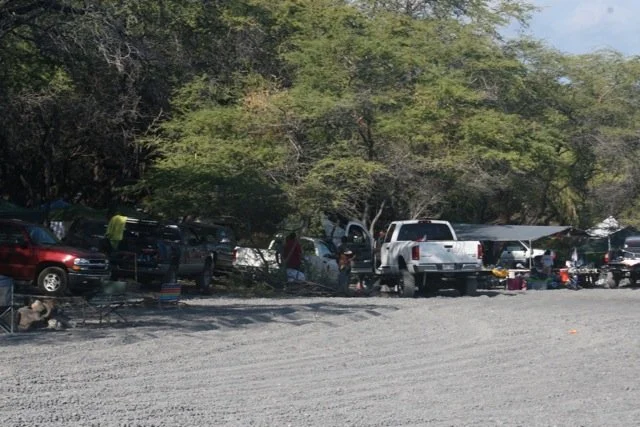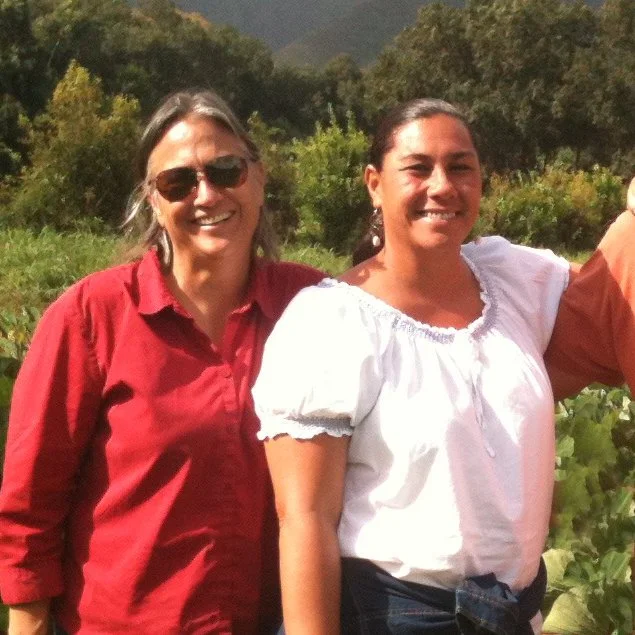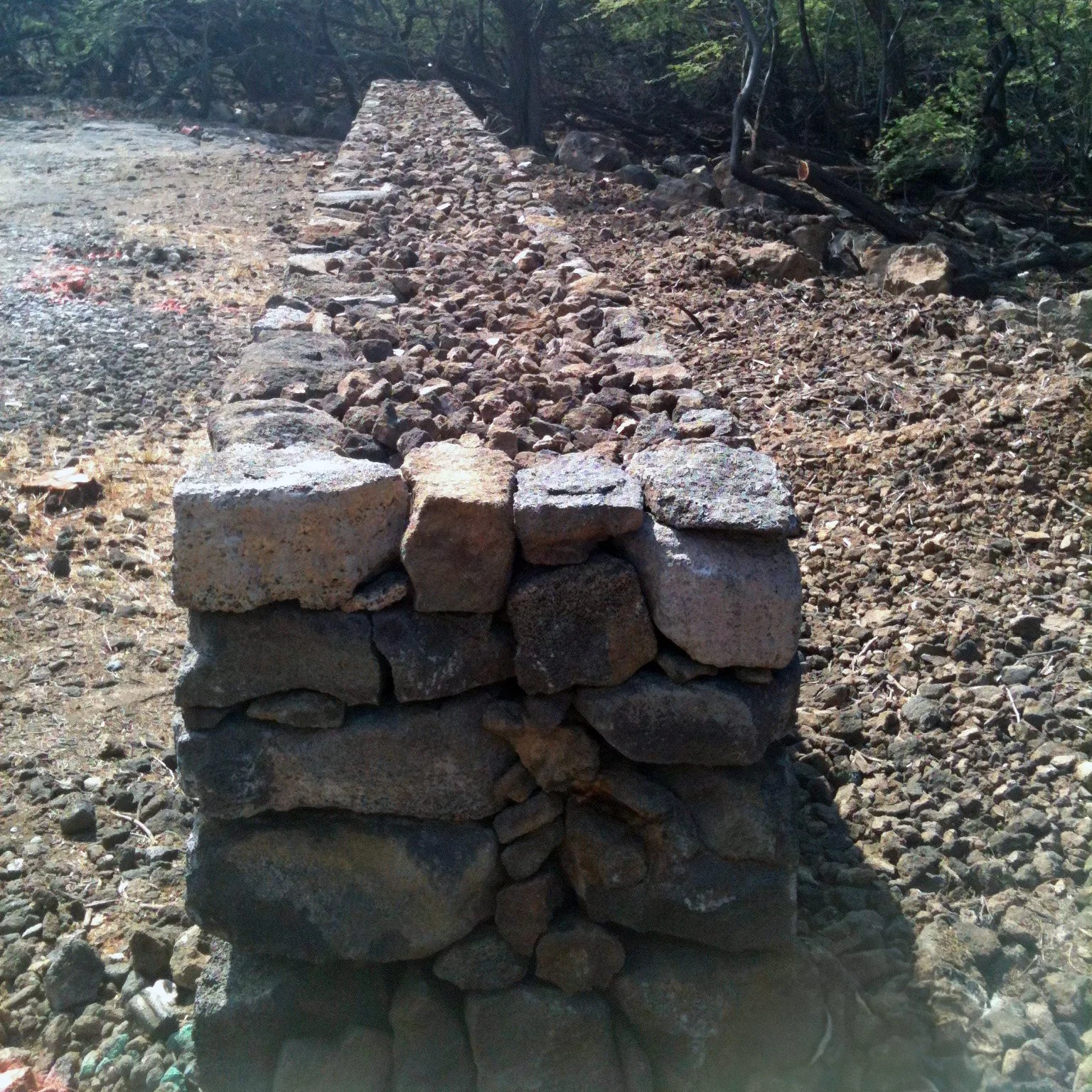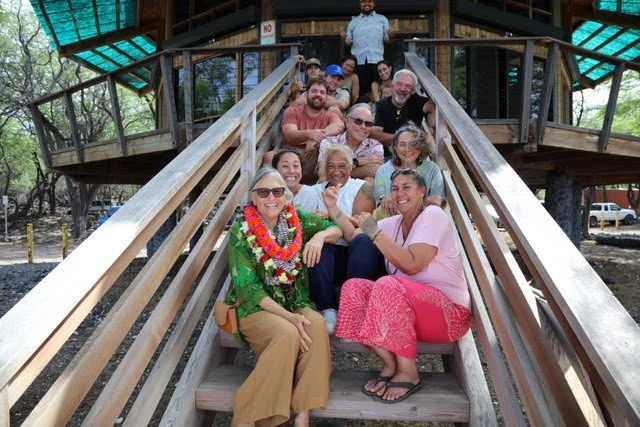It’s early afternoon on Monday, November 18, 2024, and it’s a clear and sunny day at Kīholo. A gentle ‘Eka breeze pushes through the kiawe trees as laughter drifts from Hale Hoa ‘Āina, known by many as the old Loretta Lynn house.
A small gathering has come together to honor Jenny Mitchell, or “Aunty Jenny” to many, as she concludes her 17 years as president of Hui Aloha Kīholo. The group is a mix of longtime members and newcomers, sharing memories of Hui’s journey. Some stories bring laughter, while others bring tears, as they reflect on how far things have come.
This day marks the end of a chapter for both Hui Aloha Kīholo and Jenny. And yet, with all that Hui has accomplished for Kīholo, it’s remarkable to think that there was a moment that almost kept all of this from happening.
Jenny and her mother, Florence “Coco” Hind, at Kīholo.
Jenny was raised on ranches in Honomalino and Ho‘okena, South Kona. Her family frequently returned to the ahupua‘a of Pu‘uwa‘awa‘a, a land division stretching from the uplands to the sea, where her father’s family had lived for generations until the late 1950s when the mauka section of Puʻuwaʻawaʻa Ranch was sold. Many of Jenny’s family members, including her grandfather, father, and two brothers, were born on that ranch. Her great-grandfather, Robert Hind, and his wife, Hannah (Low) Hind, along with Hannah’s brother, Eben Low, established Pu‘uwa‘awa‘a Ranch. Hannah Low spent much of her childhood at Kīholo in the late 1800s, attending school and church in an old stone building that still stands today. A Kahu or Kumu would arrive by canoe to conduct church services or teach school for the village.
Visiting Kīholo came with a clear kuleana (responsibility). To be raised in this place meant understanding its rhythms, needs, and the stewardship that came with being part of it. The families didn’t just manage the flow of people; they guided their behavior, ensuring respect for the land. Visitors followed pono practices, ensuring sustainability for future seasons. The families of lineal descendants were the caretakers of the ahupua‘a, including Kīholo. Kuleana was taught and practiced.
One such pono practice applied to fishing. During Kamehameha's reign, he upheld sustainable principles passed down from prior generations. He had the systems in place to educate the people and manage kapu (prohibition). There would be intervals, lasting about five to six months, where fishing was open for all. "At the end of this period restrictions were again placed over certain fish in order that they might increase. These restrictions were also extended to the deep-sea fishing grounds.” -Samuel Manaiakalani Kamakau, Ruling Chiefs of Hawaii. With limited resources, Kamehameha understood that balancing consumption with propagation was essential.
Kīholo's delicate balance of people and place was forever altered in the 1970s with the construction of Queen Ka‘ahumanu Highway. The new road physically cut through the Pu‘uwa‘awa‘a ahupua‘a, severing the natural mauka-to-makai flow that had long sustained the land and the people. Change continued when country music legend Loretta Lynn’s Kīholo property was purchased by the late Kīholo resident Earl Bakken, inventor of the pacemaker. In December 2000, this property became part of a land swap between the State of Hawai‘i and Bakken, ultimately transferring ownership of the beach property to the state. The state, now the owner of this southern section of the bay, made a decision that would change Kīholo: they opened the gates.
During its worst times, vehicles covered Kīholo, driving across the ‘ili‘ili that lines the beach.
With unrestricted access and no management plan in place, Kīholo began to suffer. The kuleana of caring for it was difficult and broken. No one was watching out for Kīholo. Hundreds of cars covered the beach on long weekends, broken glass littered the shoreline, makeshift toilets found in lava tubes, and sacred sites were desecrated. People who had once considered Kīholo home, the lineal descendants and longtime caretakers, stopped coming. It was too painful to see the place they loved in such a state.
When faced with a tragic situation like this, we arrive at a pivotal moment in our lives - a proverbial fork in the road. We can either stand by, saddened but resigned to the loss, or we can choose the more challenging path: the path of action. Taking action often requires a catalyst, a moment of clarity that compels us forward. For Jenny, that moment came one night at Kīholo.
Jenny was camping on the ‘ili‘ili at Kīholo when she was awakened by something unmistakable: Kīholo was groaning. The land itself was in pain. She felt the earth beneath her, heard the ocean rise, and the land crying. And in that moment, she knew what had to be done. Kīholo wasn’t just suffering - it was calling out.
One of the top priorities was to bring the people who love Kīholo back to care for it, hui aloha Kīholo (group who loves Kīholo). One of those 'people of place' was Ku‘ulei Keakealani. Together with Jenny, they became actively involved with a Task Force set up by the Pu‘uwa‘awa‘a Advisory Council, then led by Mike Donoho, to address the area in Kīholo where the State of Hawaii had allowed public access but without any management put into place. Hui began organizing cleanups, but it quickly became clear that volunteer efforts alone wouldn’t be enough. The damage ran deeper. During this time of uncertainty, Jenny and Ku‘ulei knew it was time to move, it was up to them to take action. If real change was going to happen, they needed more than good intentions, they needed a voice, resources, and authority. They needed to be official. And so, Hui Aloha Kīholo became a 501(c)(3) nonprofit.
Jenny and Ku‘ulei Keakealani.
The nonprofit now needed to put a directive statement in writing to strategically guide its efforts and ensure a unified approach to stewardship. Since the beginning, Hui Aloha Kīholo has been guided by a clear mission: to protect, perpetuate, and enhance the cultural and natural landscape of the Kīholo Bay area through collaborative management and active community stewardship. Hui’s mission is rooted in the principles of mālama ‘āina (caring for the land) and laulima (collective effort), ensuring that stewardship is a shared responsibility. This vision statement would now lead this new organization.
With that official status came a seat at the table, but with it came the responsibility to advocate for Kīholo in a meaningful way. As Jenny put it, "[Kīholo] needs to be represented, and her voice needs to be heard above all the others - all the other agendas." Jenny, along with a dedicated group of Hui members including her husband Billy Mitchell, her brother Mike Hind, and Ku‘ulei Keakealani—traveled to Oʻahu to meet with the heads of Hawaiʻi Division of State Parks, DLNR, and then-Lieutenant Governor James "Duke" Aiona Jr. They passionately presented their case for Kīholo, emphasizing the urgent need for stewardship and responsible management. The state agreed: something had to change. And so, a bold decision was made - the park would be closed for two months to clear the debris and install necessary infrastructure for protecting the beach.
Winning over state officials was one thing; convincing the public was another. Town hall meetings were contentious. Some saw the closure as an attempt to restrict access, not realizing that the goal was to ensure that access could continue in a way that was pono. But Hui Aloha Kīholo remained steadfast. The park was closed, and in those two months, something extraordinary happened. Old families returned. Volunteers showed up. Trash was hauled away, trails were restored, campsites were designated, and for the first time in years, Kīholo began to breathe again.
Mike Donoho, who played a key role in the early stewardship discussions for Kīholo, observed that Jenny "united the community to restore the Kīholo she knew and cherished in her youth." Wanting to see Kīholo thrive once more brought Jenny and Ku‘ulei motivation, knowing that so many others shared their vision for its restoration.
When it came time to reopen, the state declared there would be no camping. They simply didn’t have the resources to manage it. But camping had always been part of Kīholo, a connection point between people and place. Hui Aloha Kīholo pushed back: If the state couldn’t manage camping, then Hui Aloha Kīholo would. And they did. To this day, the nonprofit oversees the camping system, ensuring that those who come to Kīholo do so with respect and responsibility.
Barriers were installed using traditional techniques during the closure in 2011.
Since the park’s temporary closure and restoration efforts, Kīholo has begun to thrive once more. The transformation has been remarkable, as the land and ocean have had the opportunity to recover, and the people who cherish Kīholo have reconnected with the 'āina. Hui Aloha Kīholo has grown and evolved significantly since its inception.
Nahaku Kalei, former Executive Director of Hui Aloha Kīholo, helped to solidify the framework for the organization. This helped Hui Aloha Kīholo move from an urgent response team into a well-established organization with long-term management strategies.
The Hui has also expanded its programs, deepened its community partnerships, and strengthened its role as a leader in collaborative stewardship. Today, Kīholo stands as a testament to what is possible when people come together with purpose and aloha.
The success of Hui Aloha Kīholo was never about one person - it was about kākou, the collective effort of many. Jenny reflects, "One of the biggest things I've learned is the importance of working and collaborating with so many different people and entities." It was kākou that reunited the community with Kīholo. It was kākou that persuaded the state and the public to support much-needed change. It was kākou that guided the Hui through every challenge, strengthening its foundation. And it is kākou that will ensure its future.
Waia’elepī, once covered in brush, is now thriving and has seen a resurgence of ‘ōpae‘ula (Hawaiian red shrimp).
Hui Aloha Kīholo has made significant strides in its mission. It has restored native coastal ecosystems, removed invasive species, and encouraged sustainable fishing practices that honor traditional knowledge. It has started the process of restoring kuleana. The perpetuation of cultural practices has been central to their mission, ensuring that the deep connection between people and place remains intact for future generations. Educational programs have flourished, providing hands-on experiences for students and visitors alike, teaching them about Kīholo’s rich history, and ecological significance. These efforts have not only safeguarded Kīholo’s natural and cultural resources but have also inspired a new generation of caretakers who will continue this vital work.
Now, one of Hui's greatest dreams has become a reality. Hale Hoa ‘Āina, once the neglected Loretta Lynn house, has been restored into a vital base for education, management, and stewardship. Chad Wiggins, Executive Director of Hui Aloha Kīholo, explains that “Kīholo’s Hale Hoa ʻĀina accelerates our Mission by providing a safe office and meeting facility at Kīholo. Thanks to generous donations from Dan and Allison Rose and Renewable Energy Services Hawaiʻi, with substantial support from volunteers and our team, we now have an off-the-grid fully functional field office to advance our mission like never before.”
As Hui Aloha Kīholo embraces modern tools and technology to support its mission, Jenny’s vision for Kīholo’s future remains deeply rooted in its past. A future where both Kīholo and its people thrive together in a balanced, symbiotic relationship. A future where children learn to fish, where families gather to care for the land, and where Kīholo remains a source of life and connection for generations to come.
As Monika Frazier, Fundraising and Education Specialist at Hui Aloha Kīholo, explains, "Advocating for what is pono is not always easy, but I have learned that when we lead with aloha - for both people and ‘āina - we can break down barriers, find solutions that allow us to fulfill our mission, and create the space for individuals to thrive."
A celebration honoring Jenny’s 17 years as president of Hui Aloha Kīholo, on the stoop of Hale Hoa ‘Āina.
Jenny could have chosen to stand aside, allowing Hui Aloha Kīholo to remain just a fleeting idea. But alongside others who love Kīholo, she took the more difficult path: the path of action. In the face of challenges, hesitation was never an option, as she felt called by a higher purpose. When the vision emerged, everything else became clear. Even in moments of uncertainty, she remained steadfast, believing that "Ke Akua is with us and we're moving, and it's because it is pono." That sense of validation guided her every step. "There was a spirit in me that really took me from that point right up through today," she reflected. She moved with unwavering integrity and purpose, and now, she embraces a new role - one of guidance and support for the next generation of stewards.
When asked what Kīholo means to her, she answered with one word: 'ohana. She elaborated on the many layers of meaning within that word. In one sense, Kīholo is like kupuna, offering deep wisdom and guidance. In another, it is like a child, in need of care, protection, and nurturing to ensure its future.
As she steps down as president and moves into an advisory role, Jenny is optimistic about the future. She never saw herself as a leader, but when Kīholo called, she answered. Now, she knows that leadership is not just about stepping up, it is also about knowing when to take a supporting role. A fresh wind is blowing through Kīholo, and she is ready to watch it carry Hui Aloha Kīholo forward, ensuring that the relationship between people and place remains strong. Because Kīholo is not just a place - it is ‘ohana.







